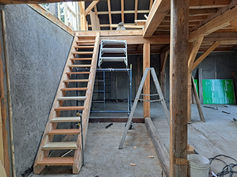SOME OF OUR recent CREATIONS

Wood Shed Venables Valley
Forest fire hazard is a big issue now in the dry interior of British Columbia. We have low grade selected our watershed woodlot to thin the forest so no canopies are touching. This is returning to pre-colonial industrial forest standards so fire can return without burning too hot and moisture can once again return to the forest floor. This, in turn, will increase the humidity bubble at the soil horizon. The wood from this project was part of our thinning forest fire prevention program in Venables Valley.

Mid-West Windmill Museum, Indiana
I helped to document this important restoration of one of America's foundational forms of technology. Kendalville, Indiana is home to one of the most interesting museums documenting the importance of this tool in the development of the American landscape.
The interesting and tragic story is unfortunately all too common in our modern wood designed world. The introduction of acrylic petroleum paints to the new world has brought untold destruction to the exteriors of our wood structures. Walk around any town, city or farm and look at the north side of any building. You will most likely find wood rotting from the inability to breathe trapped moisture from its cell structure.
Notice the colonial house I took a photo of below. I unfortunately took far too many photos of beautiful wood houses rotting their outer skins away to the homeowners great expense.
Traditional linseed oil paint is thankfully being revived once again and this will help us restore and maintain 100s of years of longevity in our exterior clad wood buildings.

Caribbean Cottage
Hurricane Irma is in everyone's mind on this small Caribbean island of St. John. It was hit hard by the hurricane and according to a friend i made there, not one leaf was left on the island after the storm. The buildings that remain and are now being b built are designed for these incredible forces of uplift and implosion on the structure.
The design of this frame is exceptional. It was wood purchased from Brazil. Known as Ipe and Cumaru it is called Brazilian teak and are harder and heavier than teak. The crew learned about the difficulties of joining this incredibly hard and heavy wood. It was milled and fabricated in Illinois. Then shipped to St. John for raising.
As Prana Timber Frames primary focus is top soil erosion prevention using low grade selection forestry and a return to uneven mature and old growth forest that maintain the highest standards of water quality and quantity, it is always a question of where the wood comes from and how was the forest managed.
Prana Timber Frames goal is align with design and construction firms that have this as their focus as well.
I love the hip roof vernacular of the island which is a design feature to prevent uplift on the roof structure. I also love how they back light the interior to showcase these incredibly beautiful roof systems.

WEST COAST RAIN FOREST STYLE
Advanced Energy Efficiency and Local Timbers
This home on the West Coast of British Columbia, exhibits the latest in energy efficiency and local sustainable timber work design.
(click on an image for the tour)

























































































